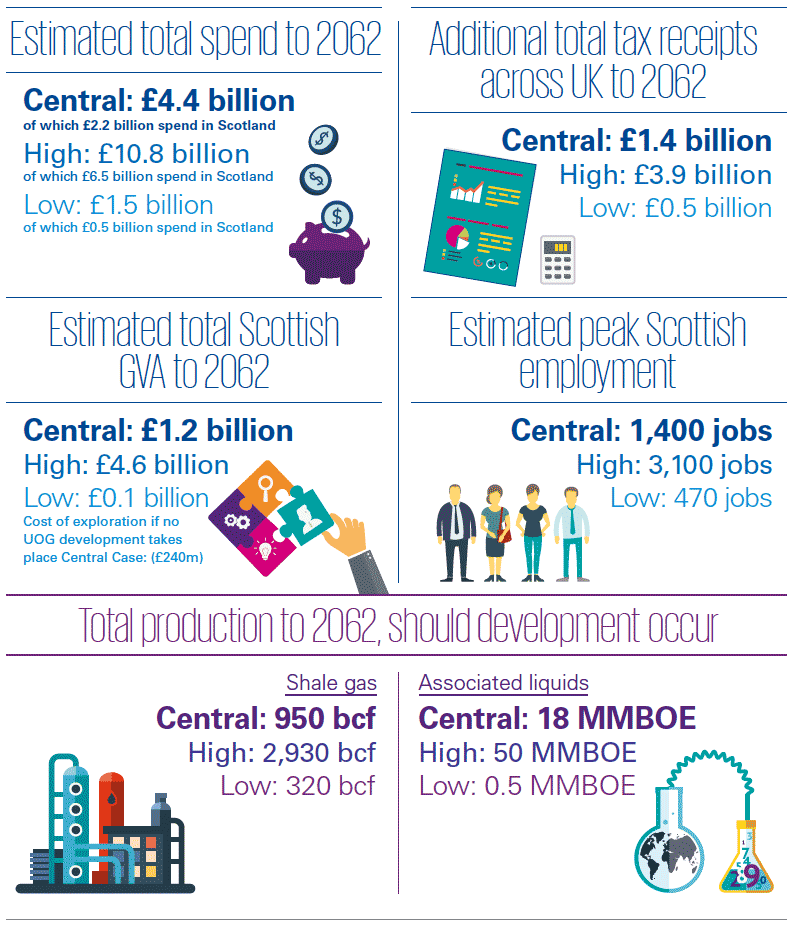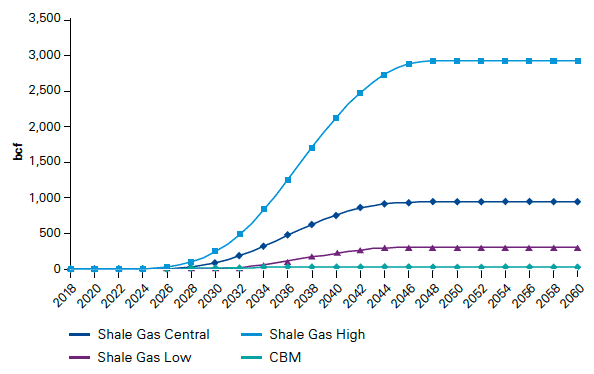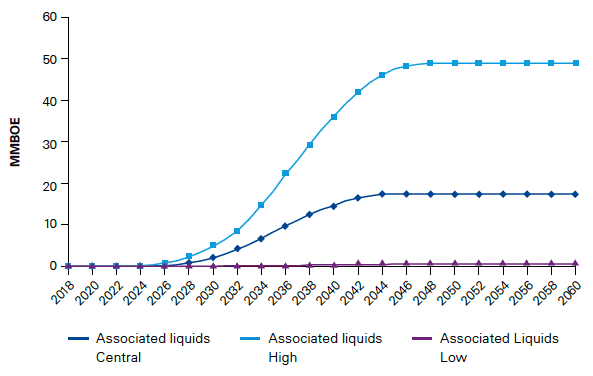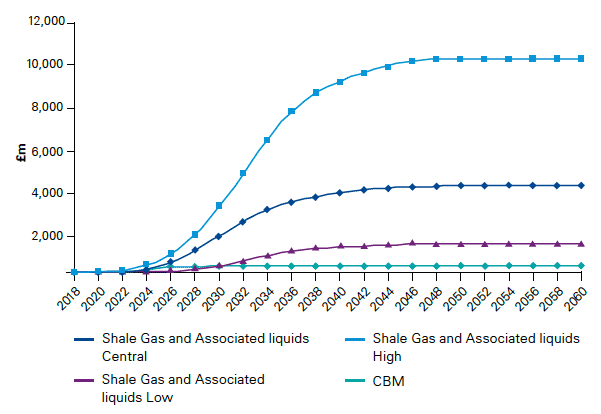Unconventional oil and gas: Economic Impact Assessment and scenario development of unconventional oil and gas in Scotland
Research into Economic Impact Assessment and scenario development of unconventional oil and gas in Scotland.
1 Executive summary
1.1 Background
The development of unconventional oil and gas ( UOG) - shale gas, associated liquids and Coal Bed Methane ( CBM) - has been gathering pace in a number of countries around the world in recent years, including the USA, Australia and Poland. The exploitation of UOG resources has been associated with economic benefits in the USA. However, the potential environmental impacts of some of the processes used to recover UOG resources are controversial.
In the UK, a number of sites have been identified which have geological characteristics that indicate potential sources of unconventional of oil and gas. These sites include the Midland Valley of Scotland which lies between the Highland Boundary Fault and the Southern Upland Fault and the Bowland Shale area and Hodder and Weald basins (in England). The British Geological Survey ( BGS) has estimated that the range of shale gas resources in place in Scotland could be between 49.4 trillion cubic feet (tcf) and 134.6 tcf with a central estimate being 80.3 tcf (British Geological Survey, 2014). The range of estimates for shale oil resources in place by BGS is between 3.2 and 11.2 billion barrels (bnbbl) with the central estimate for resource being 6.0 bnbbl.
The most recent report on UOG in Scotland is the 'Report on Unconventional Oil and Gas' by the Independent Expert Scientific Panel (2014) on behalf of the Scottish Government. The Independent Expert Scientific Panel study assessed the scientific evidence relating to UOG and included summaries of the geological and seismic evidence. It also considers at length the regulatory requirements for the development of the UOG sector in Scotland as well as the technical, environmental and societal challenges associated with the development of UOG. The Independent Expert Scientific Panel conclude that there could be potential for positive economic impacts in terms of jobs created, taxes paid and gross value added from developing the UOG sector in Scotland. The report also identifies that there are environmental or societal impacts such as concerns around water contamination, public health, seismicity, climate impacts and wider social impacts that will need to be carefully considered, and recommends that communities are consulted regarding those impacts.
Some UOG-related exploration activity has taken place in England, for example Cuadrilla Resources' exploration activities in Lancashire. In Scotland, while two licences for areas in the Midland Valley have been granted, a moratorium on giving planning consents for UOG development was put in place in January 2015 while full consideration was given to the impacts of UOG exploitation.
To support the Scottish Government's assessment of the benefits and challenges of UOG development, a number of research projects were commissioned by the Scottish Government including:
- Understanding and monitoring induced seismic activity;
- Decommissioning, site restoration and aftercare - Obligations and treatment of financial liabilities;
- Understanding and mitigating community level impacts on transport;
- Economic impacts and scenario development;
- Climate change impacts; and
- Separately, a Public Health Impact Assessment ( PHIA) of UOG development is also being evaluated.
This KPMG Report presents the findings of the economic impact assessment and scenarios development. Reports regarding the other matters listed above were prepared by other parties retained by the Scottish Government.
1.2 The scope of this Report
This Report is an independent KPMG assessment of the potential economic impacts of the development of UOG resources in Scotland. Our independent view has been based on a range of sources including: stakeholder input gathered during stakeholder workshops run as part of this research project (see Appendix D.1 for details of stakeholders that participated in the workshops) and their written input submissions to us, publicly available information and our analysis of that information. The scope of work that this Report covers is:
- Identification of the potential aggregate impact of UOG development on the Scottish economy under a range of scenarios;
- Consideration of the specific impacts of the development of UOG in Scotland and, in particular, the key sectors and groups likely to be affected; and
- Consideration of the potential nature and extent of any community benefit payments.
For the purposes of this study, UOG activities are limited to shale gas with liquids being developed as an associated product using hydraulic fracturing and Coal Bed Methane ( CBM) developments. KPMG understands that Underground Coal Gasification is subject to a separate review process and is not within the scope of this study.
Given this scope of work we have used the following approach:
- Defined the economic impacts of UOG development in Scotland to be evaluated as part of the study;
- Prepared a range of scenarios, in consultation with stakeholders, for the nature and timing of potential development of UOG in Scotland and for how that development may impact business and the Scottish economy;
- Evaluated how the potential development of UOG may impact other parts of the Scottish economy. To do this we use the concept of Gross Value Added ( GVA) which shows the economic contribution to the economy of a sector or industry. We considered direct, indirect and induced impacts. These effects are often described as 'trickle down' or multiplier effects. We consider two multiplier effects:
- Indirect effects generated in the UOG supply chain; and
- Induced effects arising from the spending of those employed by the UOG industry and its supply chain.
We evaluate these multipliers using an analysis of the Input-Output tables prepared by the Scottish Government [1] . The Input-Output tables demonstrate the impact one sector of the economy (in this case, UOG) has on other sectors. In the case of UOG, these impacts may be demand for materials and products from other sectors in the Scottish economy or by supplying a local source of fuel or feedstock to other sectors of the economy.
- Assess impacts on employment and GVA in Scotland;
- Consider impacts on taxation receipts in the UK.
We also include a qualitative assessment of some other factors to be considered as part of the economic impact assessment that do not lend themselves to direct quantification, specifically:
- The potential benefits of the use of indigenously produced gas as a feedstock for the Scottish petrochemicals industry. The development of UOG could generate a positive effect on the petrochemical industry and its supply chain if the Scottish UOG sector were able to provide feedstock to existing manufacturing plants (Chemical Industries Association, 2012).
- Other impacts, which are beyond the scope of formal quantification for this research project, such as the impact on house prices in UOG development areas, impacts on the environment, agriculture and the development of renewable energy.
The Scottish Government has asked us to comment on the petrochemical industry and other impacts, which we discuss in Section 5 of this Report.
1.3 Important to note
There are five key points associated with the evaluation of any benefit of UOG development that will need to be considered before any decisions regarding UOG development are made.
1) If oil and gas prices were to remain at historically low levels, it would be unlikely that UOG resources in Scotland could be developed economically. A low gas price environment for an extended period of time would mean that development of the UOG resources would be unattractive and therefore the economic benefits that could arise from UOG development identified in this report would not materialise. The estimated cost of UOG gas in the Central scenario in this report is approximately 45p/therm, the average of the Department of Energy and Climate Change ( DECC) [2] projected gas prices in their low scenario for the forecast period is 43p/therm demonstrating the current economic challenge for developing UOG resources in Scotland. Commodity prices are volatile and sensitive to factors such as supply and demand, economic growth and geopolitical events and any final investment decisions in UOG development will need to consider appropriate price forecasts at the time of the decision.
2) Further exploration work is required to identify, with more accuracy, the UOG resources that are in place and the production potential of the Midland Valley in Scotland. The results of the exploration activity will determine the feasibility of successful commercial development of the UOG resources. Following exploration it is viable that commercial development is not possible in which case the cost of exploration (estimated to be £240m) would have been incurred, however the economic benefits of UOG development identified in this report would not arise.
3) The external costs and impacts of developing UOG such as environmental and societal impacts and impact on visual amenity are not quantified but are discussed qualitatively in Section 5.
4) Development of UOG in Scotland will also rely on an ability to obtain appropriate funding (debt and/or equity) to support exploration and extraction.
5) There is considerable uncertainty regarding trends in Scottish, UK and global energy markets and prices that are difficult to predict. Although the cost data used is the latest available, it is over two years old. This increases the level of uncertainty surrounding any conclusions we are able to draw from our analysis and should be factored into the readers' own interpretation of our findings. The uncertainty of assumptions made is also compounded by the fact that we have sought to assess the development of the UOG sector in Scotland to 2062 [3] , a long time period over which much may change. All of these factors would impact the conclusions presented here. The level of uncertainty is why we have considered a range of development scenarios in this Report, as described below.
1.4 Industry development scenarios
Previous research undertaken by BGS has clearly demonstrated the considerable uncertainties regarding the UOG resources that could be developed in Scotland due to the complex geology, meaning that reserves and recovery estimations are not currently possible without further drilling and testing [4] . To address this uncertainty we have developed a number of industry development scenarios, covering aspects such as:
- Resource development stages (number of pads developed and the number of wells per pad);
- Volumes of shale gas and associated liquids that are produced;
- Costs for development. The costs for development and production are based on publicly sourced data from previous studies prepared by the Institute of Directors (2013) and EY (2014). These are the latest publicly available data for UK costs and may not reflect the most up-to-date understanding of costs;
- Planning and resource development timescales;
- The share of UOG development and products spend that is in the Scottish economy; and
- Decommissioning strategies and associated costs.
Following workshops with stakeholders, UKOOG provided us with some of their members' views on UOG development in Scotland. The scenarios developed for the purposes of this study are therefore based on UKOOG's submission as well as wider information gathered from stakeholders and through the literature review - this includes the IoD report on shale gas (2013) and the EY report on shale gas and its supply chain (2014). KPMG discussed the scenarios with UKOOG and took on board their comments. As a result, the scenarios reflect a range of outcomes in the development of UOG in Scotland. We would like to thank UKOOG for their input into the development of UOG scenarios. Three production scenarios in which exploration is successful were assessed [5] :
- Central scenario - based on midpoint estimates of potential production;
- High scenario - in which significant development occurs for the next decade or so; and
- Low scenario - in which development is initially slow and does not grow significantly, for example there is a low level of production. This scenario was developed based on a suggestion from stakeholders of Scottish Environment LINK and Friends of the Earth Scotland. This does not imply any endorsement of the scenario by these stakeholders.
We also consider a scenario in which development does not take place following some exploration activity either because UOG resources prove not to be as expected or because commercial development is not feasible. In this scenario, the economic benefits identified in this analysis would not arise and operators involved in exploration would incur a loss.
It is unlikely these scenarios will cover all possible outcomes however, it is possible that detailed assessments of the UOG resource potential for Scotland reveals that the resources are not viable for economic production. A final assessment of which production scenario is most likely would depend upon detailed exploration work.
Table 1.1 presents a summary of the key parameters for each development scenario.
The cumulative costs for the three production scenarios are shown in Figure 1.3 and set out in more detail in Appendix C.
According to our estimates, the UOG industry could represent, on average, 0.1% of Scottish GDP (2015) in our Central scenario and 0.3% in our High scenario which is not a large contribution to the Scottish economy.
Table 1.1 The scenarios we have considered: key parameters.
| Product | Units | Central | High | Low | ||
|---|---|---|---|---|---|---|
| What could be produced | Shale gas | Cumulative output by 2062 | bcf | 947 | 2,934 | 316 |
| Lifetime production per pad | bcf | 47.3 | 94.7 | 31.6 | ||
| Associated liquids | Cumulative output by 2062 | MMBOE | 17.8 | 49.7 | 0.5 | |
| Lifetime production per pad | MMBOE | 1.2 | 2.4 | 0.1 | ||
| CBM | Cumulative output by 2062 | bcf | 26.3 | 26.3 | 26.3 | |
| Lifetime production per pad | bcf | 13.1 | 13.1 | 13.1 | ||
| How much would be produced (development approach) | Shale gas | Number of pads | No. | 20 | 31 | 10 |
| Wells per pad | No. | 15 | 30 | 10 | ||
| Production life of a well | Years | 15 | 15 | 15 | ||
| Associated liquids | Number of shale gas pads also producing associated liquids | No. | 15 | 23 | 8 | |
| Wells per pad | No. | 15 | 30 | 10 | ||
| Production life of a well | Years | 15 | 15 | 15 | ||
| CBM | Number of pads | No. | 2 | 2 | 2 | |
| Wells per pad | No. | 15 | 15 | 15 | ||
| Production life of a well | Years | 12 | 12 | 12 | ||
| How much would it cost | Shale gas and associated liquids | Capex [6] | £bn | 3.0 | 7.2 | 1.0 |
| Opex | £bn | 1.3 | 3.2 | 0.4 | ||
| Decommissioning | £bn | 0.1 | 0.4 | 0.1 | ||
| Expenditure within Scotland | £bn | 2.2 | 6.5 | 0.5 | ||
| CBM | Capex [7] | £bn | 0.3 | 0.3 | 0.3 | |
| Opex | £bn | 0.1 | 0.1 | 0.1 | ||
| Decommissioning | £bn | ~0.0 | ~0.0 | ~0.0 | ||
| Expenditure within Scotland | £bn | 0.2 | 0.2 | 0.2 | ||
| Community benefits payments and taxation | Shale gas, associated liquids and CBM | Community benefit payments | % of revenue | 4% | 4% | 4% |
| Taxation assumptions | Direct taxes: corporate tax payable on taxable company profits. Income tax and National Insurance contributions on salaries. | |||||
| Indirect VAT on purchases with supply chain. Local government: business rates charged on a per pad basis. | ||||||
| Estimated FTE employment per pad | Shale gas and associated liquids | Number of FTE jobs at peak [8] | FTE | 80 | 90 | 55 |
| CBM | Number of FTE jobs at peak [9] | FTE | - | - | - | |
Notes: These assumptions have been development based on input from UKOOG as well as previous studies by EY and IOD
Estimated benefits should UOG development proceed in Scotland

Notes:
The results presented here exclude CBM development.
Estimated peak employment relate to spend in Scotland. These roles may not necessarily be taken by Scottish citizens.
Figure 1.1 Shale gas total cumulative output.

Figure 1.2 Associated liquids total cumulative output.

Figure 1.3 Shale gas and associated liquids total cumulative cost.

Total annual gas consumption in Scotland (2014) is estimated at 164 bcf/year [10] (The Scottish Government, 2015) [11] . With a total production of 947 bcf of gas in our Central scenario, this represents about 5.5 years of Scottish consumption. In our High scenario (2,934 bcf) this represents about 18 years of Scottish consumption.
Figure 1.1 shows that total cumulative output for gas is 947 bcf in year 2048 in the Central scenario, while it reaches, 2,934 bcf in year 2049 in the High scenario and 316 bcf in year 2047 in the Low scenario. The different peak year in the different scenarios reflects the planning and pad development timescales we have assumed. CBM reaches maximum production of 26 bcf in year 2035. Similarly, Figure 1.2 shows that total cumulative output for associated liquids is 17.8 MMBOE in year 2044 in the Central scenario, while it reaches 49.7 MMBOE in year 2048 in the High scenario and 0.5 MMBOE in year 2048 in the Low scenario.
Figure 1.3 shows that total cumulative costs are £4.4 billion in the Central scenario, £10.8 billion in the High scenario, £1.5 billion in the Low scenario and £0.4 billion for CBM in 2048.
1.5 Assessment of the economic impact on Scotland
The analysis we have undertaken demonstrates some economic benefits for the Scottish economy from UOG development if the development of the industry is in line with our Central or High scenarios. The Low scenario also demonstrates some economic benefits but to a much lower extent. The results [12] of our analysis are summarised in Table 1.2 below.
Table 1.2 Estimated cumulative economic impact from UOG development scenarios in Scotland to 2062 [13] .
| Central | High | Low | |
|---|---|---|---|
| Total spend (£bn) | 4.4 | 10.8 | 1.5 |
| Spend in Scotland (£bn) [14] | 2.2 | 6.5 | 0.5 |
| Total additional economic impact of UOG spend in Scotland (£bn) | 1.2 | 4.6 | 0.1 |
| Additional jobs created (at peak) | 1,400 | 3,100 | 470 |
| Additional tax receipts (in UK) [15] (£bn) | 1.4 | 3.9 | 0.5 |
| Community benefits payments (£m) | 217 | 663 | 63 |
In our Central scenario, the direct expenditure of £2.2 billion on the development of UOG to 2062 in Scotland could give supply chain benefits and other induced economic benefits of an additional £1.2bn (direct, indirect and induced) and be responsible for the creation of c1,400 jobs (at peak) in the Scottish economy, including jobs in construction, water transport, financial services, repair and maintenance, legal activities, architectural services, etc. It should be noted however that, in the Central case, £1.2bn of benefit over the life of UOG development and production equates to c£30m pa.
In effect, in the Central case, for £1 invested in the Scottish UOG sector a further 60 pence of economic benefit is secured for the economy. These benefits are increased in the High scenario in which the industry develops to a far greater degree. These benefits could be further increased if CBM could be profitably developed.
These potential benefits should be assessed in the context of a cumulative exploration spend of £240m in the Central case which could be at risk if there is no scope for economic production of UOG in Scotland or if further exploration activity demonstrates that resources are not sufficient to justify further development ( i.e. operators involved in exploration would incur a loss).
1.6 Links to other Scottish Government UOG research projects
The economic impact assessment also links to some of the other work being performed as part of the programme of research being undertaken on behalf of the Scottish Government regarding UOG. Specifically:
- We have provided details of the production scenarios to the Committee on Climate Change to support its analysis of climate change impacts;
- We have provided the production and decommissioning scenarios to AECOM Ltd (the supplier appointed by the Scottish Government for the decommissioning study), to support its analysis of decommissioning, site restoration and aftercare.
1.7 Acknowledgment
As part of our preparations for this research project, we sought input from key stakeholders recommended by the Scottish Government in the development of UOG in Scotland including UKOOG (the body representing the UK onshore oil and gas industry), Friends of the Earth Scotland, Scottish Environment LINK, the Broad Alliance and COSLA. We would like to thank those stakeholders that provided input into the preparation of this study.
Contact
There is a problem
Thanks for your feedback